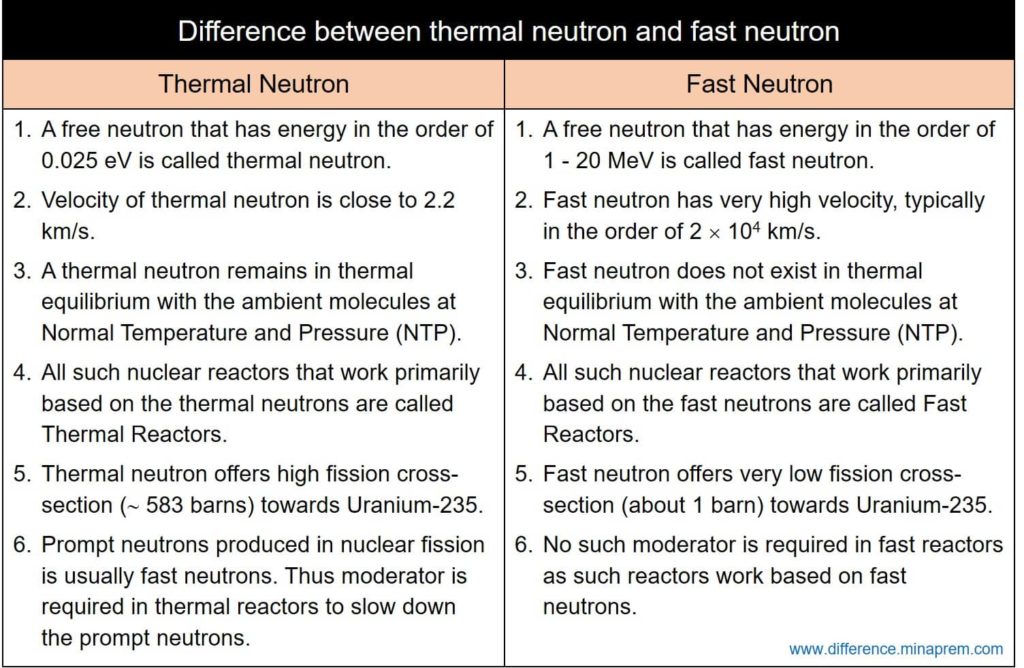Neutron is a sub-atomic particle situated within the nucleus of the atom. It is electrically neutral (i.e. chargeless particle) and has mass slightly higher than that of the proton. Neutrons, together with protons, are called nucleons. When the neutron stays within the nucleus, it remains highly stable and can be expelled by nuclear transmutation only. However, when a neutron stays outside the nucleus, it becomes highly unstable and undergoes radioactive decay into a proton, an electron and an antineutrino with the half-life of about 10 minutes. Such a neutron is called free neutron. This free neutron has several applications, the most notable one is the initiation of nuclear fission reaction. In fission, the heavier nucleus splits into two or more lighter nuclei when the former one is bombarded by the high velocity neutrons. Although other sub-atomic particles can also be employed to serve this purpose, free neutron is the most suitable one. According to Maxwell–Boltzmann statistic, any gaseous particle (atom or molecule) that has temperature higher than absolute zero (0K) possesses certain velocity and kinetic energy owing to haphazard movement. A free neutron also follows this Maxwell–Boltzmann distribution. Hence, the higher is the temperature of the free neutron, the higher will be the velocity and its corresponding kinetic energy.
Based on the energy of the free neutron, it can be classified into several groups – each group consists of a range in neutron energy. Cold neutron, Thermal neutron, Cadmium neutron, Slow neutron, Fast neutron, etc. are few groups of free neutrons having different ranges of energy. By definition, a thermal neutron is a free neutron that has kinetic energy of about 0.025eV, which indicates a velocity of about 2.2km/s at 20°C. It provides very high fission cross-section (indicates the probability of starting a fission reaction) towards Uranium-235 isotope. Thus it is commonly used in reactors of the nuclear power plant to initiate nuclear fission reaction. Such a reactor is called thermal reactor. Owing to high fission cross-section, thermal reactor based nuclear fission power plants require low enrichment (3 – 5%) of the uranium fuel. On the other hand, a fast neutron has an energy range of 1 – 10MeV, which is corresponding to a velocity of the order of 20,000km/s. It has low fission cross-section towards U-235 isotopes, and thus high enriched uranium fuel (15 – 20%) is required in fast reactors to compensate for the loss in cross-section. Prompt neutrons that are produced in every fission reaction are all fast neutrons. Thus a moderator is required in thermal reactors to slow down the speed of such prompt neutrons before allowing them to strike another nucleus to continue the chain reaction. In fast reactors, however, no moderator is required as such reactors are based on fast neutrons only. Various similarities and differences between thermal neutron and fast neutron are provided below in table format.
Similarities between thermal neutron and fast neutron
- Both the terms are associated with free neutrons only (i.e. neutron that is not within the nucleus of any atom).
- Both type of neutrons are chargeless (i.e. electrically neutral). In fact, a neutron, when situated within nucleus of an atom, remains electrically neutral (electron is negatively charges, while proton is positively charged).
- Both type of neutrons have same rest mass (approximately 1.6749 × 10−27 kg).
- Both the neutrons are capable of initiating nuclear fission reaction; however, corresponding probability varies widely. Accordingly, both type of neutrons can be used in reactors for nuclear power plants. However, design and working principle of thermal reactor differ from that of fast reactor.
- Both type of neutrons are hazardous to human health.
Difference between thermal neutron and fast neutron
| Thermal Neutron | Fast Neutron |
|---|---|
| A thermal neutron remains in thermal equilibrium with the ambient molecules at Normal Temperature and Pressure (NTP). This indicates the average kinetic energy of one thermal neutron is same with that of any gas molecule at 20°C. | Fast neutron does not exist in thermal equilibrium with the ambient molecules at Normal Temperature and Pressure (NTP). |
| A free thermal neutron has energy in the order of 0.025 eV (minor deviation possible). | Fast neutron has significantly higher energy, in a range of 1 – 20 MeV. |
| Velocity of thermal neutron is close to 2.2 km/s. | Fast neutron has very high velocity, typically in the order of 2×104 km/s. |
| All such nuclear reactors that work primarily based on the thermal neutrons are called Thermal Reactors. | All such nuclear reactors that work primarily based on the fast neutrons are called Fast Reactors. |
| Thermal neutron offers very high fission cross-section (about 583 barns) towards Uranium-235 (it is the most common fuel isotope for nuclear reactors). | Fast neutron offers very low fission cross-section (about 1 barn) towards Uranium-235. Thus very high enrichment is required in fast reactor fuels. |
| Prompt neutrons produced in nuclear fission is usually fast neutrons. Thus moderator is required in thermal reactors to slow down the prompt neutron speed so that such neutrons can induce further fission to sustain chain-reaction. | No such moderator is required in fast reactors as such reactors work based on fast neutrons (purpose of the moderator is to reduce the speed of a neutron, i.e. to convert a fast neutron into thermal neutron). |
| In today’s world, thermal neutrons have extensive application in nuclear power plants. | Fast neutrons have extensive application in fast neutron therapy for treating cancer. |

References
- Neutron Physics by M. Yeater (Elsevier, 2012).
- Neutrons and Related Gamma Ray Problems by E. Amaldi, U. Fano, L. V. Spencer, M. J. Berger (Springer Science & Business Media, 2012).
- Cancer Neutron Capture Therapy by Y. Mishima (Springer Science & Business Media, 2013).